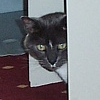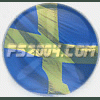Repaint Tutorial on Hand Painting - Part 2
Start Painting!
After a lot of hard work on getting all the layers sorted on our Wholefuse_right.PSD file, we are now ready to paint it!
Once again, we open Photoshop, and our Wholefuse_right.PSD file. Also display the Layers window (Window > Layers) if it isn't already there. Select the “Paint here" layer too. Now, on the upper left corner of the layers window you will see a drop-down box saying “Normal".
 That is the layer's mode. If you change it to Multiply, anything painted over something darker than white will appear darker than the actual colour. Sounds confusing? Here is an example:
That is the layer's mode. If you change it to Multiply, anything painted over something darker than white will appear darker than the actual colour. Sounds confusing? Here is an example:
Image 1

Image 2
Image 1 is a line of paint done on the Paint Here layer with the Layer mode set to “Normal". Image 2 is the same line of paint with the Layer mode set to “Multiply". In Image 2, you can see that the joint-lines on the fuselage appear like they are showing-through the red paint. This is almost exactly how the lines look in real life when painted-over and that is why Multiply is so beautiful.
So if you have got what I have said above about multiply, let's move on
By looking at the pictures, I can see that the main thing, and first thing we would paint are the three stripes passing from just under the doors. Go ahead and open the Take-off photo that we had collected from Airliners.net earlier on in Part 1. Since we know that the stripes along the fuselage are straight, and do not have any fancy swirls or waves, what we need to do is to determine exactly where they pass from. From the take-off nose picture, we can understand that they are just under the door, and they start from the very beginning of the fuselage.
Before we start on the strip, we will need to get the correct blue colour from the official logo. Open the EPS file of the logo, give it a resolution of 500dpi again, and zoom in a little, to about 50%. Next, choose the Eyedropper tool (I call it the Jawdropper tool
 and click on the blue part of the logo to capture the colour. Now click on the Pencil tool.
and click on the blue part of the logo to capture the colour. Now click on the Pencil tool.  The Paint brush is not too good for drawing very straight lines, since it is Anti aliased in Photoshop. Now, from the Window menu, click on Info. The box that appears will display the coordinates of the mouse. Then with the pencil, come to the very start of the fuselage, and come a little below the door, and click to plant a dot there. Before moving the mouse from the dot, look at the y coordinate in the Info window. Then go to the VERY back of the fuselage, come to the same y coordinate with the pencil, and this time Shift + Click to join the two dots. Check that the line is perfectly straight, if it is, congratulations
The Paint brush is not too good for drawing very straight lines, since it is Anti aliased in Photoshop. Now, from the Window menu, click on Info. The box that appears will display the coordinates of the mouse. Then with the pencil, come to the very start of the fuselage, and come a little below the door, and click to plant a dot there. Before moving the mouse from the dot, look at the y coordinate in the Info window. Then go to the VERY back of the fuselage, come to the same y coordinate with the pencil, and this time Shift + Click to join the two dots. Check that the line is perfectly straight, if it is, congratulations 
Following the same steps, go a little further down (not too much, the strip isn't that thick) plant a dot, measure the coordinates, and then join the two points by Shift-Clicking. Very easy!
Now you have two lines. We will need to fill in the gap with the same colour blue paint. Select the Paint bucket, set the tolerance to 50-55 and click between the space until it fills up completely.

Since there are three stripes on the livery, leave some space, make another strip, leave more space and make the last strip by following the same steps. It's quite easy. Try to make the gaps between spaces and the thickness of the strips Identical. You should end up with a result similar to this:

If the lines do not appear to be too identical, and look a little bad, try measuring the thickness of the line by subtracting the y- coordinate of the top of the line, and the y- coordinate of the bottom. Do this for the strips, too, and you'll have perfect 3 stripes
After the stripes we will need to place the Air Malta Logo. Before you hurry up and copy from the EPS file, I would like to explain the best way to align logos.
Aligning logos similar to this Air Malta logo, is VERY easy in most cases. All you have to do is to count the windows. Yes, that's right. We measure how wide the logo is in “Window" units. I can see from the Takeoff picture again that the tip of the A starts from the beginning of the 1st window, and the logo continues until the end of the 9th window. So it's 9 windows wide… Easy, huh?
To copy the logo off the EPS file we will use my easy system again

Copy the logo once you have selected it properly, and then paste it into the fuselage. You will again notice how huge the logo actually is!

Firstly, open the layer window if it isn't open. You will see a new layer called “Layer 1". This is the Layer of the Logo, so name it to “Air Malta Logo".
Next, select the “Move" Tool. You will notice a box around the logo, and four nods on each corner. Click on one of the nods in the corner, and drag it inwards, so that the logo gets smaller. When It's at a reasonable size, press Enter to apply transformation, and the jaginess that had occurred while resizing will go.

The logo is now more handle able, but still too big. Remember that it was 9 windows wide? Let's reduce it again from the corner to make it 9 windows wide…

Now it's almost exactly 9 windows wide, and at a normal size. You might have to play with the height of the logo a little, until it looks just right. For vertical alignment, I noticed that a couple of pixels above the red marks round the 8th window is just right for the vertical alignment.
Set the Layer mode of our logo to Multiply, so that any fuselage lines going through it will not stay behind it.
Congratulations! It is a great skill to place a logo on a plane and make it match exactly, and it sure does develop when practiced! This is one of the most important parts of painting in my opinion and needs to be practiced a lot…
Now we have almost completed the fuselage of our repaint! We just need to add the reg now, which is very easy because we will use Arial font, and the same colour as the strips… Open a picture that shows the whole of the aircraft. I can see that the reg is around 3.75 windows wide from the end of the fuselage. Click on the “Horizontal Type Tool" in Photoshop (Let's call this the Text Tool even though it's not what Photoshop calls it
 . I chose the reg 9H-ABQ so firstly get the blue strip colour and then click somewhere on the fuselage to write the reg. If it's too big or too small, adjust the size to fit around 3.5 to 4 windows. You might want to adjust the height too to fit the one on the photo. It should look something like this:
. I chose the reg 9H-ABQ so firstly get the blue strip colour and then click somewhere on the fuselage to write the reg. If it's too big or too small, adjust the size to fit around 3.5 to 4 windows. You might want to adjust the height too to fit the one on the photo. It should look something like this:
We're almost done. The next thing we will need to add is the flag of the EU and the Flag of Malta. If you look careful near the reg you will see it on one of the photos. It's very easy to get flags off Google. I have pulled off these two:
EU Flag
Malta Flag
Right click and save these into the Photo Material folder as “EUFlag.gif" and “MaltaFlag.gif"
Any photo you pick off Google will be way too big for where we will place it, so you won't have to worry about size…
Now, open the EU flag in Photoshop and paste it onto the fuselage. It's HUGE so we'll have to heavily resize it. Make it the same height as the reg, and looking at a photo, place it quite close to the right side of the door. Name its layer “EU Flag". It should look something like this:

You can make the colour of the flag a more vibrant blue if you wish, by selecting the paint bucket, setting the tolerance to 10 and painting the flag.
Now let's move on to the Malta Flag. Again, paste it into the fuselage and resize it. Make it the exact same size as the EU flag, and looking at the picture, place it on the other side of the door. It should look roughly like this:

CONGRATULATIONS! You have finished the first part of painting an aircraft! Part 3 will explain how to paint the tail and engines whereas Part 4 will explain how to add shadows, dirt and other effects to the repaint. Thanks for reading, Part 3 will arrive tomorrow since it's 12:30am here


















